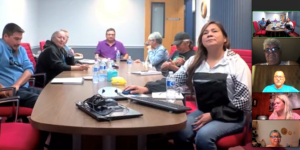Magnetawan First Nation welcomes the Nisga’a Lisims Government to share knowledge on citizenship

By Rick Garrick
MAGNETAWAN FIRST NATION — Information about Nisga’a citizenship cards and citizenship requirements and the importance of practising inclusion for determining citizenship were featured at an Anishinabek Nation Governance Agreement presentation in Magnetawan First Nation on Sept. 20.
Cherie Mercer, citizenship registry manager at Nisga’a Lisims Government in B.C., says the Nisga’a citizenship card was implemented about seven-to-eight years after the Nisga’a Final Agreement treaty came into effect in 2000.
“Its intention is for our citizens to have a recognized ID within our own treaty offices and our own institutions – so our village governments and our own departments within Nisga’a government,” Mercer says. “Our closest town is Terrace, which is 100 kilometres away, and some of the banks and institutions there accept our card, and the airports within the province also recognize our card. We do plan to have the card recognized with Canada.”
Mercer says they do not use blood quantum for Nisga’a citizenship, noting that they use four eligibility criteria for determining citizenship: matrilineal, patrilineal, married in, or adopted as a child. The Nisga’a currently have about 8,000 citizens and they are growing by about 100 new births per year.
“We have a saying here that any amount of blood is Nisga’a,” Mercer says. “There is no limit in regards to the single parent or amount of blood quantum somebody has, we don’t measure that.”
Pat Madahbee, Anishinabek Nation Commissioner on Governance and former Grand Council Chief, says the Nisga’a have been very generous in providing information on the “ground-breaking work” they have done ever since the Anishinabek Nation began the Anishinaabe Governance process.
“It’s a real inspiration to us here to hear the great work that you’re doing,” Madahbee says. “It’s another example of the fact that we have to have the confidence that we can do this ourselves, we don’t need Ottawa continuing to tell us what to do.”
Madahbee encourages people to not get caught up in the blood quantum system, noting that it is not an Anishinabek notion.
“The blood quantum thing was brought up by the Bureau of Indian Affairs (in the United States) to eliminate people, just like these designations are to eliminate people in Canada,” Madahbee says. “Canada has done like the United States, they practice exclusion and we should be practising inclusion.”
Madahbee encourages communities to create genealogical charts or family trees of the families in their community.
“When you have events and a lot of people are home, maybe put up a big chart on the wall and have people add their family names to that,” Madahbee says. “We did that back in 2000 in Aundeck Omni Kaning; we had a homecoming gathering because it was a millennium year and we had people show up that had never been here before from Florida, from B.C., from different parts of the States and Canada. We know there were originally nine families here and now we’ve expanded with the different names that have gone on — that genealogical chart is now quite extensive.”
Madahbee stresses that the Anishinaabe Governance process is a journey.
“Long before the people started coming to this land, we had highly civilized nations and our own forms of government,” Madahbee says. “The [Dodemaag] system in the modern context talks about responsibilities, whether it’s a responsibility to provide health services or education services. We’re not asking anyone to go back to the 1700s or 1600s, but to think in the modern-day context of what the responsibilities are to provide services to the community.”
Madahbee says the Anishinabek Nation Governance Agreement focuses on four areas of jurisdiction: Leadership Selection; Citizenship; Language and Culture; and Operation and Management of Government.
“We’re not getting totally out of the Indian Act right now,” Madahbee says. “That was on the advice of the Nisga’a — they told us to take in on in an incremental basis because when they took on everything all at once, they didn’t have the capacity and the skill sets to take it all on.”

